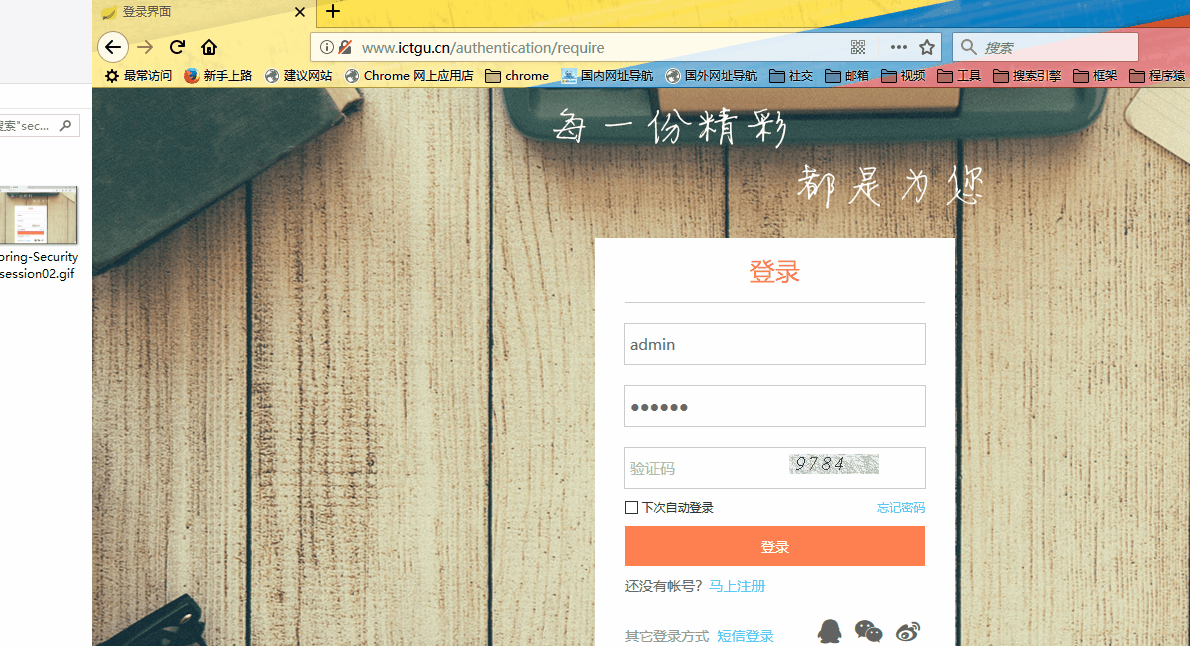Spring Security是一个能够为基于Spring的企业应用系统提供声明式的安全访问控制解决方案的安全框架。它提供了一组可以在Spring应用上下文中配置的Bean,充分利用了Spring IoC,DI(控制反转Inversion of Control ,DI:Dependency Injection 依赖注入)和AOP(面向切面编程)功能,为应用系统提供声明式的安全访问控制功能,减少了为企业系统安全控制编写大量重复代码的工作。
前言
spring security 3.0已经可以使用spring el表达式来控制授权,允许在表达式中使用复杂的布尔逻辑来控制访问的权限。
常见的表达式
Spring Security可用表达式对象的基类是SecurityExpressionRoot。
| 表达式 | 描述 |
|---|---|
hasRole([role]) |
用户拥有制定的角色时返回true (Spring security 默认会带有ROLE_前缀),去除参考Remove the ROLE_ |
hasAnyRole([role1,role2]) |
用户拥有任意一个制定的角色时返回true |
hasAuthority([authority]) |
等同于hasRole,但不会带有ROLE_前缀 |
hasAnyAuthority([auth1,auth2]) |
等同于hasAnyRole |
permitAll |
永远返回true |
denyAll |
永远返回false |
anonymous |
当前用户是anonymous时返回true |
rememberMe |
当前勇士是rememberMe用户返回true |
authentication |
当前登录用户的authentication对象 |
fullAuthenticated |
当前用户既不是anonymous也不是rememberMe用户时返回true |
hasIpAddress('192.168.1.0/24')) |
请求发送的IP匹配时返回true |
部分代码:
......
private String defaultRolePrefix = "ROLE_"; //ROLE_前缀
/** Allows "permitAll" expression */
public final boolean permitAll = true; //全部true
/** Allows "denyAll" expression */
public final boolean denyAll = false; //全部false
public final boolean permitAll() {
return true;
}
public final boolean denyAll() {
return false;
}
public final boolean isAnonymous() {
//是否是anonymous
return trustResolver.isAnonymous(authentication);
}
public final boolean isRememberMe() {
//是否是rememberme
return trustResolver.isRememberMe(authentication);
}
......
URL安全表达式
onfig.antMatchers("/person/*").access("hasRole('ADMIN') or hasRole('USER')")
.anyRequest().authenticated();
这里我们定义了应用/person/*URL的范围,该URL只针对拥有ADMIN或者USER权限的用户有效。
在Web安全表达式中引用bean
config.antMatchers("/person/*").access("hasRole('ADMIN') or hasRole('USER')")
.antMatchers("/person/{id}").access("@rbacService.checkUserId(authentication,#id)")
.anyRequest()
.access("@rbacService.hasPermission(request,authentication)");
RbacServiceImpl
@Component("rbacService")
@Slf4j
public class RbacServiceImpl implements RbacService {
/**
* uri匹配工具
*/
private AntPathMatcher antPathMatcher = new AntPathMatcher();
@Override
public boolean hasPermission(HttpServletRequest request, Authentication authentication) {
log.info("【RbacServiceImpl】 --hasPermission={}", authentication.getPrincipal());
Object principal = authentication.getPrincipal();
boolean hasPermission = false;
//有可能是匿名的anonymous
if (principal instanceof SysUser) {
//admin永远放回true
if (StringUtils.equals("admin", ((SysUser) principal).getUsername())) {
hasPermission = true;
} else {
//读取用户所拥有权限所有的URL 在这里全部返回true
Set<String> urls = new HashSet<>();
for (String url : urls) {
if (antPathMatcher.match(url, request.getRequestURI())) {
hasPermission = true;
break;
}
}
}
}
return hasPermission;
}
public boolean checkUserId(Authentication authentication, int id) {
return true;
}
}
效果如下:
Method安全表达式
针对方法级别的访问控制比较复杂,Spring Security提供了四种注解,分别是@PreAuthorize , @PreFilter , @PostAuthorize 和 @PostFilter
使用method注解
- 开启方法级别注解的配置
@Configuration @EnableGlobalMethodSecurity(prePostEnabled = true) public class MerryyouSecurityConfig extends WebSecurityConfigurerAdapter { - 配置相应的bean
@Bean @Override public AuthenticationManager authenticationManagerBean() throws Exception { return super.authenticationManagerBean(); } @Override protected void configure(AuthenticationManagerBuilder auth) throws Exception { auth.userDetailsService(userDetailsService).passwordEncoder(passwordEncoder()); } @Bean @ConditionalOnMissingBean(PasswordEncoder.class) public PasswordEncoder passwordEncoder(){ return new BCryptPasswordEncoder(); } - 在方法上面使用注解
```java
/**
- 查询所有人员
*/
@PreAuthorize(“hasRole(‘ADMIN’)”)
@ApiOperation(value = “获得person列表”, notes = “”)
@GetMapping(value = “/persons”)
public List
getPersons() { return personService.findAll(); } ```
- 查询所有人员
*/
@PreAuthorize(“hasRole(‘ADMIN’)”)
@ApiOperation(value = “获得person列表”, notes = “”)
@GetMapping(value = “/persons”)
public List
PreAuthorize
@PreAuthorize 注解适合进入方法前的权限验证
@PreAuthorize("hasRole('ADMIN')")
List<Person> findAll();
PostAuthorize
@PostAuthorize 在方法执行后再进行权限验证,适合验证带有返回值的权限。Spring EL 提供 返回对象能够在表达式语言中获取返回的对象returnObject。
@PostAuthorize("returnObject.name == authentication.name")
Person findOne(Integer id);
PreAuthorize 针对参数进行过滤
//当有多个对象是使用filterTarget进行标注
@PreFilter(filterTarget="ids", value="filterObject%2==0")
public void delete(List<Integer> ids, List<String> usernames) {
...
}
PostFilter 针对返回结果进行过滤
@PreAuthorize("hasRole('ADMIN')")
@PostFilter("filterObject.name == authentication.name")
List<Person> findAll();
效果如下:
代码下载
从我的 github 中下载,https://github.com/longfeizheng/logback

